
The Regio X Palatium is the tenth regio of imperial Rome, under Augustus's administrative reform. Regio X took its name from the Palatine Hill and the imperial palaces located on it.

The Regio X Palatium is the tenth regio of imperial Rome, under Augustus's administrative reform. Regio X took its name from the Palatine Hill and the imperial palaces located on it.
Regio X was centred on the Palatine Hill. In extent, the region largely followed the contours of the Palatine, and so was bordered by the Velabrum on the north west, the Circus Maximus to the south west, the Via Sacra on the north east, and on the south east, a street where the modern Via di San Gregorio is now situated. A measurement taken at the end of the 4th century recorded that the perimeter of the region was 11,510 Roman feet (approximately 3.4 km), making it the second smallest of the Augustan regions. [1]

The hill itself is dominated by a series of imperial palaces, which were the residences of the emperors and their families whilst they were lodged in the city. The most prominent of these was the vast Palace of Domitian, with its three principal wings: the Domus Augustana , the Domus Flavia , and the Hippodrome of Domitian (in reality, a private sunken garden). Earlier palaces had been created by the emperors Augustus (the Domus Augusti ) and Tiberius (the Domus Tiberiana), both of which were preserved by later emperors. Later, the Domus Severiana was added by the emperor Septimius Severus, who also constructed the Septizodium (or the Temple of the Seven Suns) adjacent to it. [2]

The hill also possessed several other temples. First was the Temple of Apollo Palatinus, built by Augustus, to which was attached a library (the Bibliotheca Apollinis). The Temple of Apollo was situated next to the much older Temple of Magna Mater. Also here, according to the 5th century Notitia, was the Temple of Jupiter Victor, which is assumed to have been situated near the entrance of Domitian's Palace. [3]
This region also contained a number of sites that dated back to Rome's mythical past. Chief amongst these was the Casa Romuli (or House of Romulus, the legendary founder of Rome). Also here was the Lupercal, reputedly where the twin boys (Romulus and Remus) were suckled by a she-wolf and where the Lupercalia festivities were held, as well as the Roma quadrata. [4] Finally, at its northwestern end, the region contained the still intact Arch of Titus, the now ruined Baths of Elagabalus and the Arch of Constantine, where it terminated. At the turn of the 5th century, the Regio contained 20 aediculae (shrines), 89 domūs (patrician houses), 48 horrea (warehouses), 44 balneae (bath houses) and 89 loci (fountains). [5]
At the turn of the 5th century, the Regio was divided into 20 vici (districts) and 2,642 insulae (blocks). It had two curators and was served by 48 Roman magistrates. [6]

The Palatine Hill, which is the centremost of the Seven Hills of Rome, is one of the most ancient parts of the city and has been called "the first nucleus of the Roman Empire." The site is now mainly a large open-air museum while the Palatine Museum houses many finds from the excavations here and from other ancient Italian sites.
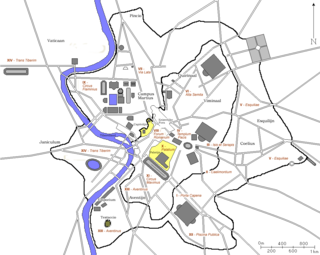
In 7 BC, Augustus divided the city of Rome into 14 administrative regions. These replaced the four regiones — or "quarters" — traditionally attributed to Servius Tullius, sixth king of Rome. They were further divided into official neighborhoods.
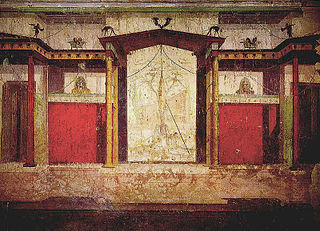
The House of Augustus, or the Domus Augusti, is situated on the Palatine Hill in Rome, Italy. This house has been identified as the primary place of residence for the emperor Augustus.

The Domus Augustana is the modern name given to the central residential part of the vast Roman Palace of Domitian on the Palatine Hill. In antiquity the name may have applied to the whole of the palace.

The Domus Transitoria was Roman emperor Nero's first palace damaged or destroyed by the Great Fire of Rome in 64 AD, and then extended by his Domus Aurea.

The Palace of Domitian was built as Roman emperor Domitian's official residence in 81–92 AD and was used as such by subsequent emperors. Its remains sit atop and dominate the Palatine Hill in Rome, alongside other palaces.

The Regio I Porta Capena is the first regio of imperial Rome, under Augustus's administrative reform. Regio I took its name from the Porta Capena, a gate of the Servian Walls, through which the Appian Way entered the city prior to the construction of the Aurelian Walls.

The Regio II Caelimontium is the second regio of imperial Rome, under Augustus's administrative reform. It took its name from the Caelian Hill, which the region was centred on.

The Regio III Isis et Serapis was the third regio of imperial Rome, under Augustus's administrative reform. Regio III took its name from the double sanctuary of Isis and Serapis, in the area of the Via Praenestina, containing the valley that was to be the future site of the Colosseum, and parts of the Oppian and Esquiline hills.

The Regio IV Templum Pacis is the fourth regio of imperial Rome, under Augustus's administrative reform. Regio IV took its name from the Temple of Peace built in the region by the emperor Vespasian. It includes the valley between the Esquiline and the Viminal hills, the popular area of the Subura, and the Velian Hill.

The Regio V Esquiliae is the fifth regio of imperial Rome, under Augustus's administrative reform. Regio V took its name from the Esquiline Hill. It contains parts of the Oppian Hill and Cispian Hill and of the Esquiline, plus the plain just outside the Servian walls.
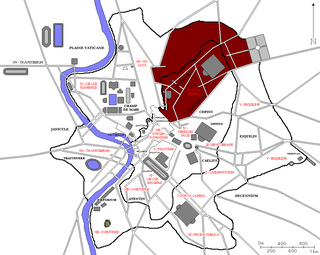
The Regio VI Alta Semita is the sixth regio of imperial Rome, under Augustus's administrative reform. Regio VI took its name from the street passing over the Quirinal Hill. It was a large regio that also encompassed the Viminal Hill, the lower slopes of the Pincian, and the valleys in-between.

The Regio VII Via Lata is the seventh regio of imperial Rome, under Augustus's administrative reform. Regio VII took its name from the wide urban street the Via Lata. It was the urban section of the Via Flaminia, which ran between the Servian walls and the Aurelian Walls, and corresponds to the modern Via del Corso. The regio contained part of the Campus Martius on the east of the street plus the Collis Hortulorum, the Pincian Hill.

The Regio VIII Forum Romanum Magnum is the eighth regio of imperial Rome, under Augustus's administrative reform. Regio VIII took its name from the Roman Forum, the political epicentre of Ancient Rome.

The Regio IX Circus Flaminius is the ninth regio of imperial Rome, under Augustus's administrative reform. Regio IX took its name from the racecourse located in the southern end of the Campus Martius, close to Tiber Island.

The Regio XI Circus Maximus is the eleventh regio of imperial Rome, under Augustus's administrative reform. Regio XI took its name from the Circus Maximus, located in the valley between the Palatine and the Aventine hills.

The Regio XII Piscina Publica is the twelfth regio of imperial Rome, under Augustus's administrative reform. Regio XII took its name from the Piscina Publica, a swimming pool that disappeared during the middle imperial period.

The Regio XIII Aventinus is the thirteenth regio of imperial Rome, under Augustus's administrative reform. Regio XIII took its name from the hill which dominated the region, the Aventine.
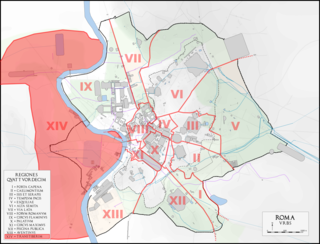
The Regio XIV Transtiberim is the fourteenth regio of imperial Rome, under Augustus's administrative reform. Meaning "across the Tiber", the Regio took its name from its position on the west bank of the Tiber River.
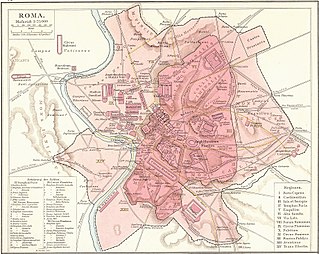
The Domus Tiberiana was an Imperial Roman palace in ancient Rome, located on the northwest corner of the Palatine Hill. It probably takes its name from a house built by the Emperor Tiberius, who is known to have lived on the Palatine, though no sources mention his having built a residence. It was enlarged by the successors to Tiberius, and would have been the principal Roman residence of Tiberius, Caligula, Claudius, and Nero during the early part of his reign. Relatively little is known of the structure archaeologically, since the Farnese Gardens have occupied the site of the main level since the 16th century, making excavation difficult.